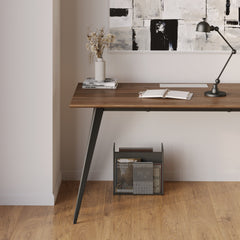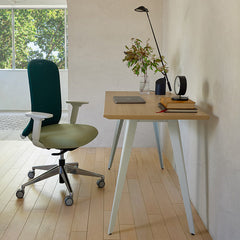Get 10% off your first order
Find the office furniture that’s designed to match your style, comfort, and needs perfectly. Subscribe
Spaces That Shift With You: Building a Workspace That Adapts to Every Task

Visit quiz page to see how we makes it easy to create an inspiring workplace


A productive workspace isn’t about filling space—it’s about shaping it. Overcrowding your desk or office often leads to distraction, fatigue, and visual chaos. The most inspiring workspaces share a common trait: clarity.
Creating efficiency doesn’t mean stripping everything away; it means choosing what truly supports your work and arranging it with purpose. Let’s explore how you can design a workspace that feels calm, organized, and open.
Your mind can become overwhelmed by visual clutter, making it more difficult to concentrate. When you simplify anything, you make room for thought, which enables you to process ideas more quickly and maintain mental clarity.
Reduces decision fatigue
Improves concentration and memory
Lowers stress and sensory overload
Boosts aesthetic harmony and flow
A well-balanced workspace doesn’t feel empty—it feels intentional.
When it comes to creating an effective workstation, a flexible desk is the cornerstone. In order to avoid overloading the space, it should offer sufficient surface area for everything that is necessary.
The Small Standing Desk Mississippi offers both mobility and adaptability, helping you balance posture and productivity without taking up too much space.
|
Setup Element |
Ideal Position |
Benefit |
|
Monitor |
Eye level, arm’s length |
Reduces strain |
|
Chair |
Adjustable height |
Supports posture |
|
Lighting |
Side or above desk |
Prevents glare |
|
Essentials |
Front-center |
Keeps focus clear |
A desk that adapts to you—not the other way around—sets the tone for efficiency.
Workspaces that are conducive to natural movements are the finest. Furniture should be arranged in such a way that it encourages movement between sitting and standing positions.
A height-adjustable standing desk keeps your body active, reducing fatigue and promoting circulation.
Leave open walking space around your desk.
Stand or stretch every 45 minutes.
Alternate between sitting and standing tasks.
Keep cords and accessories neatly organized to move freely.
Movement builds energy and prevents workspace stagnation.
Storage ought to simplify rather than complicate things. The drawers and shelves in your office may appear to be more congested than they actually are. Make sure to select furniture that conceals clutter and facilitates quick access on a daily basis.
A sleek office desk with built-in storage helps maintain order without disrupting your layout.
|
Storage Type |
Use |
Benefit |
|
Drawer units |
Small accessories |
Keeps desk surface clear |
|
Floating shelves |
Books and décor |
Opens floor space |
|
Modular cabinets |
Flexible items |
Adapts to future needs |
|
Vertical organizers |
Papers and notes |
Saves surface area |
Good storage design is invisible—it supports your workflow quietly.
The effectiveness of the workspace is significantly impacted by the lighting. When the light is too faint, it causes strain on your eyes; when it is too intense, it creates glare.
Combine natural and soft ambient lighting.
Position your desk near windows but out of direct glare.
Use warm tones to ease focus and stress.
Keep shadows away from key work areas.
Light that is well-balanced draws attention to what is important while minimizing distractions.

Studies on workspace design, like those in environmental psychology, show that open layouts enhance cognitive performance. A clean environment signals order, helping the brain prioritize tasks effectively.
Visual simplicity improves task accuracy.
Organized layouts enhance emotional stability.
Clear surfaces increase creative thinking.
Overcrowding decreases long-term motivation.
Designing for mental clarity helps sustain both focus and joy in your workspace.
When spaces are well delineated, even a small office can have the feeling of being efficient. Establish separate areas for working, storing reference materials, and taking breaks.
A modular quad workstation helps structure multi-purpose environments, offering visual and functional boundaries.
Keep a focused work zone for core tasks.
Designate a mini creative corner for notes or sketches.
Reserve one clear area for breaks or thinking.
Maintain consistent spacing between each zone.
Zoning brings structure, even when space is tight.
It is important that every item at your desk serves a purpose, or multiple purposes. The term "minimal" accessories does not indicate "boring"; rather, it means "purposeful."
|
Item |
Functions |
Benefit |
|
Adjustable lamp |
Task & ambient light |
Space saver |
|
Floating rack |
Storage & décor |
Dual use |
|
Folding chair |
Extra seating & stowable |
Adds flexibility |
|
Compact drawer |
Organizer & footrest |
Comfort meets function |
Thoughtful accessories reduce clutter and keep your setup fluid.
Ergonomics doesn’t require bulky furniture. Simple, functional designs like the ergonomic arm support can make long hours feel lighter and more balanced.
Adjustable chair with lumbar support.
Desk setup aligned with your posture.
Keyboard and mouse at neutral arm height.
Accessories that move with you.
The use of ergonomic design allows for longer, more productive, and pain-free labor.
Efficiency isn’t just about physical space—it’s about routine. A minimalist mindset helps you maintain consistency.
Remove unused items monthly.
Reevaluate storage needs quarterly.
Keep décor meaningful but limited.
Create an end-of-day reset habit.
Simplicity becomes effortless when practiced daily.
If you want your workspace to be efficient, it should also be durable. When you use eco-friendly materials with timeless design, your office will be both environmentally friendly and long-lasting.
Use reclaimed wood or bamboo furniture.
Invest in modular, long-lasting pieces.
Choose recyclable desk accessories.
Prioritize energy-efficient lighting.
Sustainable design is simple, functional, and built to evolve with you.

An efficient workspace isn’t about doing more—it’s about removing what blocks your flow. Every item should serve your purpose, every space should invite movement, and every detail should contribute to calm productivity.
Keep your layout open and breathable.
Focus on balance, not abundance.
Choose comfort and function equally.
Let your space evolve as your work does.
When design supports clarity, focus follows naturally—and productivity becomes effortless.

Spaces That Shift With You: Building a Workspace That Adapts to Every Task

Built to Support You: Why Ergonomic Tables Redefine Remote Work

The Art of Flow: Simple Table Arrangements for a Balanced Home Office
Get 10% off your first order
Find the office furniture that’s designed to match your style, comfort, and needs perfectly. Subscribe
Leave a comment